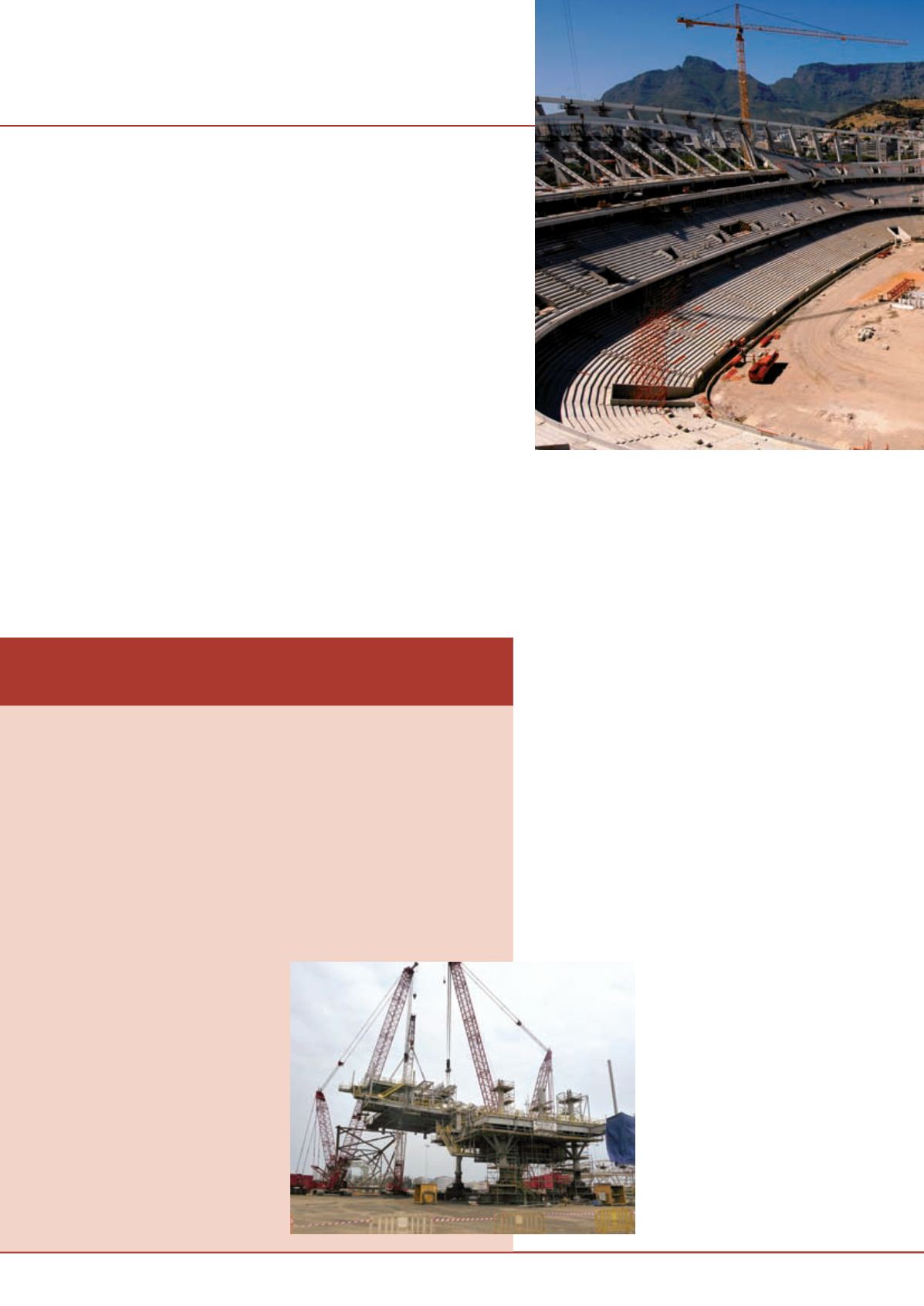
32
Branching out
REGIONAL REPORT: SOUTH AFRICA
international
construction
july-august 2013
electricity utility, Eskom.
The government will also spend ZAR 430 billion (US$ 43
billion) to build schools, hospitals, clinics, dams, water and
sanitation projects. The funds will also go towards expanding
electricity networks and supplying electricity to over a million
new homes, building more courtrooms and prisons and construct
better bus, commuter rail and road links, according to Finance
Minister Pravin Gordhan. These projects will mostly be carried
out through municipalities and provincial authorities
The state utilities also have ambitious projects ahead. Transnet,
for instance, wants to turn the old Durban airport on the
country’s east coast into a new container facility, at a projected
cost of ZAR 100 billion (US$ 10 billion).
Exploratory drilling on the site by Transnet is already underway,
and the first phase is expected to be completed by 2019. By 2036,
it will have a 16-berth container terminal that can handle 9.6
million standard twenty-foot equivalent units (TEUs).
A project of this size and complexity will put South African
companies to the test, which will offer opportunities for
international companies, says Andrew Robinson, head of the
Admiralty and Shipping department at Norton Rose Fulbright
South Africa.
“There are not many people here with experience in this sort
of thing,” said Mr Robinson. “It will require special skills, such
as understanding how concrete and sea-water react to each other
over long term. It will also involve a huge amount of excavation.
So a lot of overseas companies are watching with interest, and
some have already begun setting up offices here.”
He added that foreign entrants to the
South African market will have a steep
learning curve. By law, all government
contracts require the winning bidder to
include black equity partners. While local
companies have adapted their operating
models to include black participants, first
time entrants to the market will have to
figure their way through the process – a
daunting prospect for many.
Another hurdle is the glacial pace at
which these projects get signed off. “We
hear a lot of talk but as yet these projects
are not coming to fruition,” Ms Dlamini
noted.
Funding is the biggest fence to be
cleared, but private sector asset managers
C
ontractor Sonamet owns a fleet of 13 Manitowoc crawler cranes that are
challenged to work round the clock in Lobito, on the coast of Angola. The oldest
model – the 4000 WV – dates back to 1967, and works alongside the newest
18000 from 2011.
Sonamet is a joint venture between Subsea 7, a seabed-to-surface engineering,
construction and services contractor to the off-shore energy industry, and Sonangol, an
Angolan hydrocarbon company,
The cranes lift loads of up to 550 tonnes for the assembly of oil platforms and other
underwater/ offshore infrastructure. Conditions are tough, with the coastal location
increasing the potential for rust build-up and the entire 80 ha site is almost completely
covered in sand. On-site engineers, who were trained by Manitowoc Crane Care, perform
routine maintenance and regular checks to ensure the sustained performance and
longevity of the cranes.
Alexander Arsie, operations, yards and
assets manager at Subsea 7, said, “We
fabricate a lot of different and very large
structures so we need adaptable machines
that can be set up quickly and perform
effectively. The cranes adapt well to the
work. The older machines are put through
their paces and manage to keep up with
their younger, more modern colleagues.”
The 18000 is fitted with the MAX-ER
capacity-enhancing attachment that
increases its capacity to 750 tonnes, making
it the most powerful crane on site. The
smallest crawler is a 5500, which offers a
55 tonne capacity. Sonamet regularly uses
the cranes in tandem or in combinations of
up to four to carry out the largest lifts.
Old and new in Angola
A fleet of 13 cranes are put through their paces 24/7 in Lobito
There are however signs of improvement. First National Bank
(FNB) and the Bureau for Economic Research said that their
latest construction confidence index had jumped from 36 index
points in the last quarter of 2012 to 51 points in the first quarter
of 2013. This was the highest reading of the index in four years.
Sizwe Nxedlana, chief economist at FNB, said the surge was a
result of restored profitability in the construction sector.
“Construction firms have been able to restore profitability
following a prolonged period of intense margin pressure,”
Mr Nxedlana said. “However, this could be constrained if
construction activity growth continues at the slow pace seen in
the first quarter of 2013.”
Ms Dlamini added that the numbers appear to reflect the mood
on the ground, “We have not seen this kind of growth for a while
now. We hope this will continue.”
Large projects
Much of the hope is pinned on large state-funded projects. The
ruling African National Congress is under pressure to improve
economic growth and, especially, to create jobs – a quarter of the
country’s working-age population are unemployed.
Last year, it announced an almost ZAR 4 trillion (US$ 400
billion) infrastructure programme to be rolled out over the next
two decades, with almost ZAR 850 billion (US$ 85 billion) to
be spent within the next three years. The projects will be split
between various government departments and state-owned
enterprises, such as logistics company Transnet and national
CREDIT CITY OF CAPE TOWN


